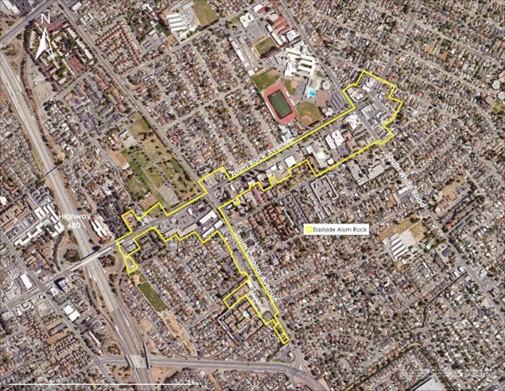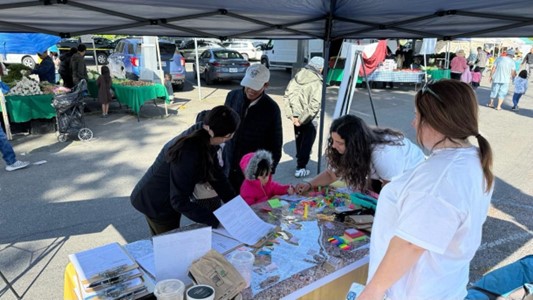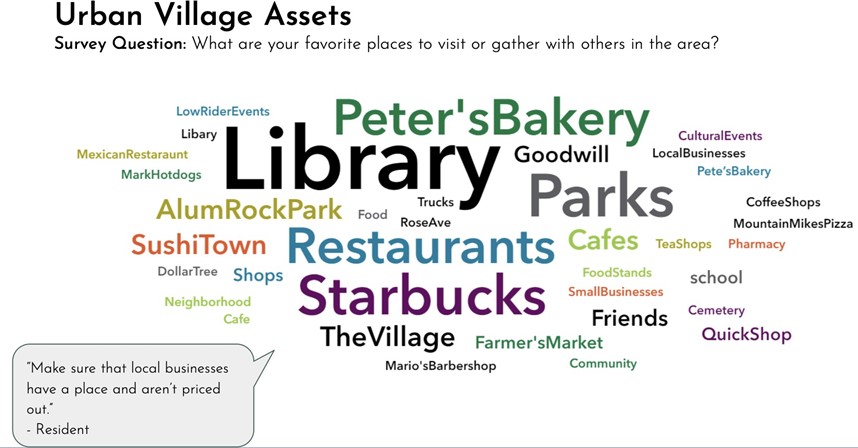By Students of Spring Capstone Studio Class, San Jose State University, Spring 2025
During January through May 2025, San José State University’s Capstone Studio Class, Engaging Eastside, undertook a planning project with the City of San José to reinvigorate the community of Eastside Alum Rock. The City is proposing to transform the neighborhood into an urban village—a mixed-use, walkable, and sustainable community—identified in its General Plan 2040. The project site (bounded by the yellow boundary line) is situated between South Capitol Avenue, White Street, Alum Rock Avenue, and Rose Street. Important locations or developments include the VTA orange stop on South Capitol Avenue, Roberto Cruz Public Library, Goodwill, Starbucks, and the beloved Peter’s Bakery.

From January through May 2025, San José State University’s Capstone Studio Class, Engaging Eastside, undertook a planning project with the City of San José to reinvigorate the community of Eastside Alum Rock. The City is proposing to transform the neighborhood into an urban village—a mixed-use, walkable, and sustainable community—identified in its General Plan 2040. The project site (bounded by the yellow boundary line) is situated between South Capitol Avenue, White Street, Alum Rock Avenue, and Rose Street. Important locations or developments include the VTA orange stop on South Capitol Avenue, Roberto Cruz Public Library, Goodwill, Starbucks, and the beloved Peter’s Bakery.
The project, Eastside Activation: Developing a More Connected and Lively Urban Village, aimed to gather community input, identify local strengths and challenges, and assess the feasibility of an urban village approach in this
neighborhood. The assessment was based on community responses, an audit of the physical attributes of the community, observations of traffic patterns, transportation options, local businesses, neighborhood amenities, and a count of murals and other public artworks.
The project, Eastside Activation: Developing a More Connected and Lively Urban Village, aimed to gather community input, identify local strengths and challenges, and assess the feasibility of an urban village approach in this neighborhood. The assessment was based on community responses, an audit of the physical attributes of the community, observations of traffic patterns, transportation options, local businesses, neighborhood amenities, and a count of murals and other public artworks.
Our class team, Engaging Eastside, divided our work into two main phases. Phase one included a detailed community assessment, the examination of the physical conditions of the neighborhood, and an analysis of the residents who call Eastside Alum Rock home. Phase two synthesized our findings into policy recommendations for the final report.
Early in the semester, the class visited the project site to walk the streets, observe daily life, and experience the neighborhood firsthand. This fieldwork provided us with a sense of what it is like to live and work in Eastside Alum Rock. The Urban Village Team from the City of San José informed the class that the community desired more art and other elements that celebrated the rich culture and history of the neighborhood. After conducting initial research and outreach to the community, we discovered that the neighborhood was predominantly populated by Vietnamese and Hispanic residents. There were sections of Capitol Avenue that had many Vietnamese restaurants, with other Hispanic businesses being located in the “Village”.
Community engagement played a major role in the project. The engagement team led four outreach events: distributing surveys at Peter’s Bakery, tabling at the local Farmers Market, hosting a “Future City Challenge” game night at James Lick High School, and gathering input at Roberto Cruz Public Library.
Each setting shaped how community members responded. For example, at the bakery, people shopping or waiting in line were less likely to participate in a survey or talk with the group conducting the survey. There was also little space outside on the sidewalk of the bakery, which made it difficult to have a presence. The Farmers Market was the exact opposite of Peter’s Bakery. Residents were very receptive to the outreach group.

The surveys and community outreach data informed the themes used for policy recommendations provided in the report. The eight major themes were community design, culture, economic development, land-use, mobility, placemaking, safety, and sustainability. Policy recommendations included implementing street furniture, public art, pop-up markets, revitalizing underused parking lots, flexi-bollard-protected bike lanes, and traffic-calming public artwork.

The Wordmap above highlights the deep pride residents have in Eastside Alum Rock. A common misconception about projects like ours is that we’re entering a place defined only by disadvantages. While these types of issues do exist, they don’t capture the whole story. For our studio class, it was essential not just to identify disadvantages and challenges but also to recognize and highlight the strengths and complex vibe of the Eastside Alum Rock community.
Although our class consists of just ten students, the scope and depth of our work have been substantial. Over the course of one semester, we conducted extensive outreach, research, writing, visual rendering, policy translation, and site analysis. Through this process, we have come to know the community so well that it feels familiar. By spending time in the community, we also gained a deeper understanding of its historical significance to the people who live there. Many families and businesses have roots that go back generations to when San José had agricultural fields. There is a lived history that the community is very proud of and wants to celebrate!
